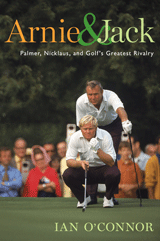Arnie and Jack
Truly phenomenal peak performers are different from the rest of us, but no two of them are necessarily alike.
That’s the primary lesson to be learned from Arnie and Jack, a fascinating double biography of Palmer and Nicklaus, by Ian O’Connor (Houghton Mifflin; $26 SRP).
Drawing upon a wide variety of sources, including interviews with both men and their principle rivals, along with their separate authorized biographies, O’Connor paints a detailed, balanced picture of the most famous American golf legends of the twentieth century.
Palmer came first on the golfing scene, nearly ten years older than Nicklaus. O’Connor shows how Palmer’s modest family history as the son of a greenskeeper affected his approach to playing, his sense of place among others, and the probable source of his incredible drive to succeed, both on and off the course.
One of the book’s first stories about Nicklaus is about his first game with Palmer, an outing involving mutual acquaintances that took place when Nicklaus was a teenager. The Ohio kid’s upbringing took place at a different class level than Palmer, although by today’s standards it would not be considered as anything more than slightly upper middle-class.
The point is that if the positions were reversed, that outing would most likely never have happened.
Even so, there are country clubs and then there are the other country clubs. Charlie Nicklaus’ status as the owner of a drugstore would not have qualified him or his family to join with the truly upper crust element. Nonetheless, the kind of life Nicklaus enjoyed while growing up probably affected his later approach to his off-course business pursuits, and not in a good way, at least compared to Palmer.
As O’Connor shows, the on-course performances of both men were enhanced by the presence of the other, at least until Palmer reached his late 30s. Each felt he was the best. Each felt compelled to prove it, especially when the other was in the same tournament.
Their competitive spirits overflowed off the course and into their relations with the press, their business interests, and with each other, sometimes in juvenile antics that can only be described as stupid funny, well into middle age.
O’Connor describes several of the major tournaments and other golfing matches in which Palmer and Nicklaus fought so hard and so well. He also devotes much of the book to showing how these two men revolutionized the interconnection between sports and business.
Palmer’s personality was a perfect fit for his long, continuing profitable career as a spokesman for an incredibly wide range of products, many of which had no connection to golf. In contrast, Nicklaus’s talents as a celebrity endorser were, shall we say, a bit longer in developing.
On the other hand, his detail-oriented focus helped him with his more successful career as a golf course designer, where his earnings have far outpaced his older rival. Their keen drive to beat the other in whatever pursuit in which they were engaged came from their shared perception that their place in golf’s pantheon of greats would not come solely from how they played.
Both succeeded so handsomely off the course probably as a direct result of this mutual insight and determination.
Jealousy and envy also played a part, as O’Connor shows. Each realized that the other had something the other lacked, and their reactions to this fact weren’t always as gentlemanly as one might hope.
Fortunately for both, they married well. Barbara Nicklaus and Winnie Palmer both were major influences on their husbands. Both helped temper the two men’s attitudes toward each other.
The two women, who became fast friends early on in their husband’s professional careers, also kept their husbands’ rivalries from becoming too vicious.
As I see it, both Palmer and Nicklaus significantly benefited from the other’s existence. It’s impossible to imagine either of these great pros having the kind of career they had, without the other one also being there.
They needed each other more than either was comfortable accepting. From a golfing perspective, however, eventually we were all the better for it.
Review Date: October 3, 2008


